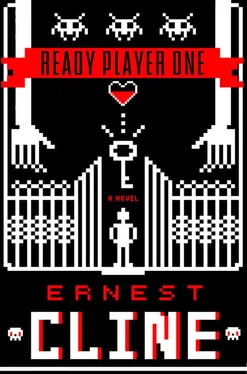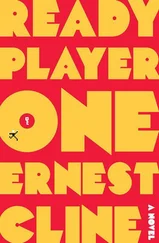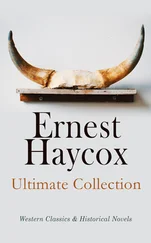As I approached the nearest tunnel entrance, I heard loud music emanating from below. I recognized the song as “Pour Some Sugar on Me” by Def Leppard, off their Hysteria album (Epic Records, 1987). I reached the edge of the glowing green ring and jumped in. As my avatar plummeted down into the museum, the green vector-graphic theme disappeared and I found myself in high-resolution full-color surroundings. Everything around me looked completely real once again.
Below its surface, Archaide housed thousands of classic video arcades, each one a loving re-creation of an actual arcade that had once existed somewhere in the real world. Since the dawn of the OASIS, thousands of elderly users had come here and painstakingly coded virtual replicas of local arcades they remembered from their childhood, thus making them a permanent part of the museum. And each of these simulated game rooms, bowling alleys, and pizza joints was lined with classic arcade games. There was at least one copy of every coin-operated videogame ever made down here. The original game ROMs were all stored in the planet’s OASIS code, and their wooden game cabinets were each coded to look like the antique originals. Hundreds of shrines and exhibits devoted to various game designers and publishers were also scattered throughout the museum.
The museum’s various levels were comprised of vast caverns linked by a network of subterranean streets, tunnels, staircases, elevators, escalators, ladders, slides, trapdoors, and secret passageways. It was like a massive underground multilevel labyrinth. The layout made it extremely easy to get lost, so I kept a three-dimensional holographic map on my display. My avatar’s present location was indicated by a flashing blue dot. I’d entered the museum next to an old arcade called Aladdin’s Castle, close to the surface. I touched a point on the map near the core of the planet, indicating my destination, and the software mapped the quickest route for me to get there. I ran forward, following it.
The museum was divided into layers. Here, near the planet’s mantle, you could find the last coin-operated videogames ever made, from the first few decades of the twenty-first century. These were mostly dedicated simulator cabinets with first-generation haptics—vibrating chairs and tilting hydraulic platforms. Lots of networked stock car simulators that allowed people to race each other. These games were the last of their kind. By that era, home videogame consoles had already made most coin-op games obsolete. After the OASIS went online, they stopped making them altogether.
As you ventured deeper into the museum, the games grew older and more archaic. Turn-of-the-century coin-ops. Lots of head-to-head fighting games with blocky polygon-rendered figures beating the crap out of each other on large flat-screen monitors. Shooting games played with crude haptic light guns. Dancing games. Once you reached the level below that, the games all began to look identical. Each was housed in a large rectangular wooden box containing a cathode picture tube with a set of crude game controls mounted in front of it. You used your hands and your eyes (and occasionally your feet) to play these games. There were no haptics. These games didn’t make you feel anything. And the deeper I descended, the cruder the game graphics got.
The museum’s bottom level, located in the planet core, was a spherical room containing a shrine to the very first videogame, Tennis for Two, invented by William Higinbotham in 1958. The game ran on an ancient analog computer and was played on a tiny oscilloscope screen about five inches in diameter. Next to it was a replica of an ancient PDP-1 computer running a copy of Spacewar!, the second videogame ever made, created by a bunch of students at MIT in 1962.
Like most gunters, I’d already visited Archaide a few times. I’d been to the core and had played both Tennis for Two and Spacewar! until I’d mastered them. Then I’d wandered around the museums’ many levels, playing games and looking for clues Halliday might have left behind. But I’d never found anything.
I kept running, farther and farther down, until I reached the Gregarious Simulation Systems Museum, which was located just a few levels above the planet core. I’d been here once before too, so I knew my way around. There were exhibits devoted to all of GSS’s most popular games, including several arcade ports of titles they’d originally released for home computers and consoles. It didn’t take me long to find the exhibit where Halliday’s five Game Designer of the Year trophies were displayed, next to a bronze statue of the man himself.
Within a few minutes, I knew I was wasting my time here. The GSS Museum exhibit was coded so that it was impossible to remove any of the items on display, so the trophies could not be “collected.” I spent a few minutes trying in vain to cut one of them free of its pedestal with a laser welding torch before calling it quits.
Another dead end. This whole trip had been a waste of time. I took one last look around and headed for the exit, trying not to let my frustration get the best of me.
I decided to take a different route on my way back up to the surface, through a section of the museum I’d never fully explored on my previous visits. I wandered through a series of tunnels that led me into a giant, cavernous chamber. It contained a kind of underground city comprised entirely of pizza joints, bowling alleys, convenience stores, and, of course, video arcades. I wandered through the maze of empty streets, then down a winding back alley that dead-ended by the entrance of a small pizza shop.
I froze in my tracks when I saw the name of the place.
It was called Happytime Pizza, and it was a replica of a small family-run pizza joint that had existed in Halliday’s hometown in the mid-1980s. Halliday appeared to have copied the code for Happytime Pizza from his Middletown simulation and hidden a duplicate of it here in the Archaide museum.
What the hell was it doing here? I’d never seen its existence mentioned on any of the gunter message boards or strategy guides. Was it possible no one had ever spotted it before now?
Halliday mentioned Happytime Pizza several times in the Almanac , so I knew he had fond memories of this place. He’d often come here after school, to avoid going home.
The interior re-created the atmosphere of a classic ’80s pizza parlor and video arcade in loving detail. Several NPC employees stood behind the counter, tossing dough and slicing pies. (I turned on my Olfatrix tower and discovered that I could actually smell the tomato sauce.) The shop was divided into two halves, the game room and the dining room. The dining room had videogames in it as well—all of the glass-top tables were actually sit-down arcade games known as “cocktail cabinets.” You could sit and play Donkey Kong on the table while you ate your pizza.
If I’d been hungry, I could have ordered a real slice of pizza at the counter. The order would have been forwarded to a pizza vendor near my apartment complex, the one I’d specified in my OASIS account’s food service preference settings. Then a slice would have been delivered to my door in a matter of minutes, and the cost (including tip) would have been deducted from my OASIS account balance.
As I walked into the game room, I heard a Bryan Adams song blasting out of the speakers mounted on the carpeted walls. Bryan was singing about how, everywhere he went, the kids wanted to rock. I pressed my thumb to a plate on the change machine and bought a single quarter. I scooped it out of the stainless-steel tray and headed to the back of the game room, taking in all of the simulation’s little details. I spotted a handwritten note taped to the marquee of a Defender game. It read BEAT THE OWNER’S HIGH SCORE AND WIN A FREE LARGE PIZZA!
Читать дальше




![Эрнест Клайн - Ready Player Two [calibre]](/books/438636/ernest-klajn-ready-player-two-calibre-thumb.webp)







